Ground Bees Be Gone (6 Home Remedies That Work!)
Unlike honey bees and wasps that nest in tree cavities and roof spaces, ground bees tunnel underground through bare patches in the lawn or yard.
Ground bees can be any bees that nest below ground.
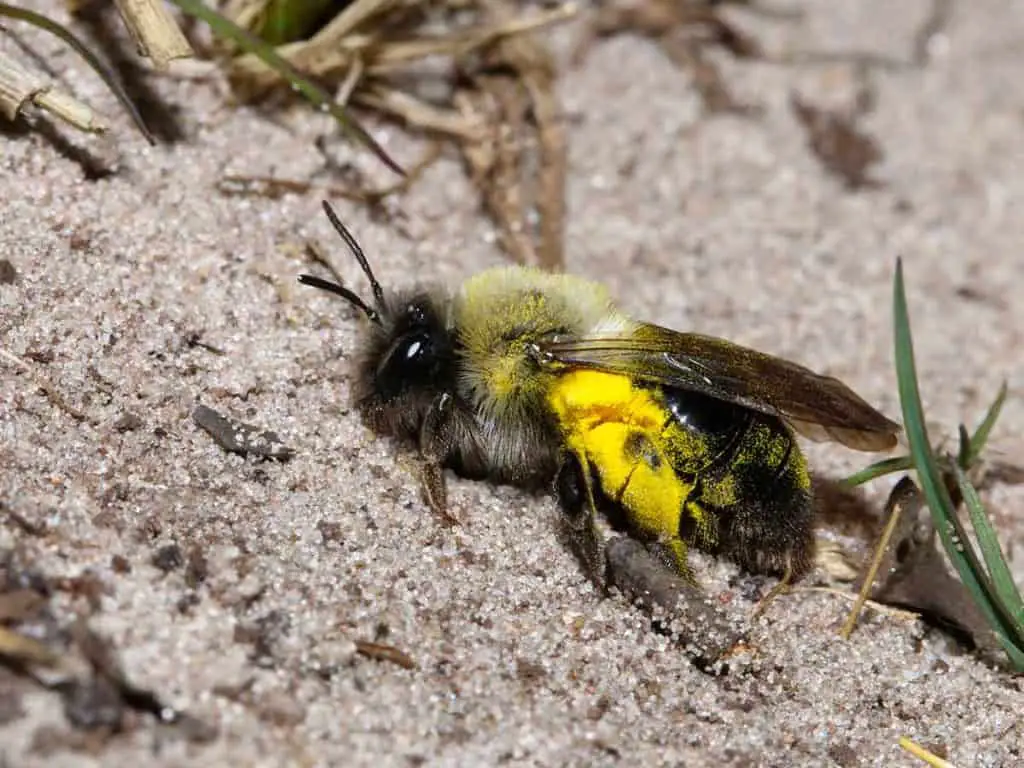
Quick Info on Ground Bees
These elements attract ground bees:
- Dry and loose soil that is easy to tunnel.
- Bare patches on the ground.
- Existing burrows in the ground left by small rodents.
How do you locate a ground bee’s nest?
Identifying a ground bee’s nest is straightforward: Small conical soil mounds next to a hole no larger than 1.5 inches in diameter in the open ground.
Read on to learn the best ways to get rid of ground bees.

THE 6 HOME REMEDIES TO GET RID OF GROUND BEES
These methods help you get rid of ground bees – employed either alone or in combination – using items you have at home or readily available on the market:
1. Use Dry Ice
Quick info: Making dry ice involves liquefying carbon dioxide and compressing it into solid ice at a temperature of -109° F.
Pour dry ice pellets into the holes where the ground bees nest. Do this in the late evening when they are back in the nests and least active.
As the dry ice melts, it releases carbon dioxide, which sinks to the bottom and suffocates the ground bees; carbon dioxide is heavier than oxygen.
Dry ice pellets that are small enough will naturally prevent the bees from escaping – but you can use rags to block the holes, to be sure.
2. Use a Bug Zapper
An adequately-powered bug zapper is effective in killing ground bees.
Switch on the device, and place it squarely over the hole. Wear long sleeves and long pants as a precaution, and stay away from the zapper as it goes to work.
Again, you should do this in the evening when the ground bees are in the nests.
Most ground-nesting bees are solitary creatures, although you may find several females nest in the same area, in which case you will need to repeat the step.
Ground-nesting bees such as yellow jackets live in colonies, and you need to leave the zapper on over the hole for longer until the snapping sound dies down.
Follow up the action with another method on this list based on the suffocation or killer liquid approach. The queen that lays eggs may still be alive deep in the nest, and you want to finish the job.
(see Best Products to Kill Ground Bees below)
3. Use Gasoline-Soaked Rag
Make a rag into a ball slightly larger than the ground bee’s nesting hole, and prepare as many as needed for the number of holes you find.
Soak it with gasoline, and stuff it into the hole to effectively block the escape route and ensure “air-tightness.”
Gasoline vapor is 3 to 4 times heavier than air, so it will travel deep into the burrow where the bees nest and suffocate them.
If you have multiple ground bee holes in the yard, you want to stuff them in quick succession.
Wear a mask and handle with care because gasoline vapor is toxic and flammable.
Execute in the evening, and you shall find dead ground bees the next morning.
4. Use a Vacuum
A wet/dry shop vac is preferable for this method.
Fill the vacuum bucket with soapy water approximately 2 inches deep.
Extend the hose and place the vacuum nozzle next to the burrow or opening where the ground bees nest. Hold the nozzle in place using a tape or heavy object.
When you run the vacuum, the sound is enough to disturb the bees and prompt them into action.
You can do this in the evening, and it will suck in the bees nesting inside and those returning.
Let the vacuum operate for 15-20 minutes.
5. Flood the Burrow with Water
Flooding with water may kill the ground bees, but it also allows them to escape – an excellent solution if you want to get rid of ground bees without killing them.
Pull and extend the garden hose, and place the nozzle over the hole. Turn on the tap and let running water – not high-pressure spray – fill the burrow.
Stay indoors to avoid angry ground bees.
6. Pour or Spray with a Homemade Solution
You have options with the homemade ground bee killer solution:
- Water with liquid dish soap, or
- Water with vinegar.
Mix one part soap or vinegar to four parts water in a spray bottle so you can spray the solution from a safe distance.
Liquid dish soap and vinegar are the active ingredients, so the higher their ratio, the quicker the result.
You can also choose to pour the solution into the hole and stuff it with a rag to prevent escape.
Spraying may allow them to leave while pouring kills them – your choice!
Best Products to Kill Ground Bees
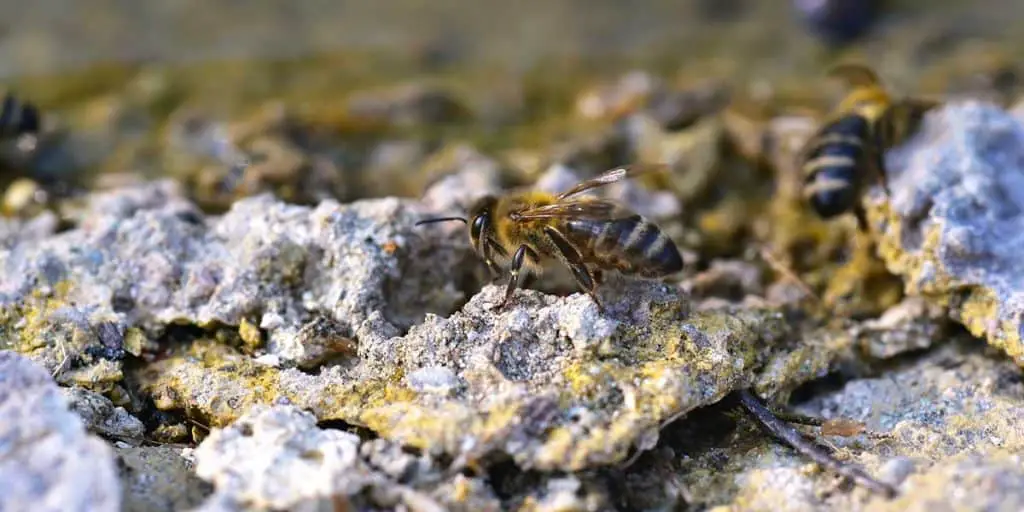
Best Insecticide for Ground Bees:
Bayer Tempo Dust Insecticide

Most insecticide sprays kill insects on contact when you can aim but are less effective when dealing with ground bees or yellow jackets as they can sting if you miss.
This insecticide is in dust form, which you apply through a nozzle and into burrows or hard-to-reach places; make sure you block the insect’s escape routes. Expect to see results in a day or two.
Unlike diatomaceous earth, Bayer’s Temp Dust remains active in moist environments.
What you get with this insecticide:
- Low odor powder form.
- Kills yellow jackets, ground bees, and most insects.
- The treatment lasts for several months and remains active in moist conditions.
- Apply in the evening or night when the insects are least active.
Best Killer for Ground Bees:
Zap It Rechargeable Bug Zapper

This racket zapper, with its 4,000-volt grid, is sufficiently-powered to kill ground bees and yellow jackets.
Switch on and place it over the insects’ entry point, and see the zapper eliminate them one after another.
Opt for the large-size zapper – its 8.3-inch width provides ample coverage to ensure no insects can escape.
What you get with this bug zapper:
- Instant death by electrocution.
- The powerful 4,000-volt grid and large frame are suitable for targeting large insects such as yellow jackets and ground bees.
- A built-in LED light.
- Lithium battery; USB-charging.
Should You Kill Ground Bees?
Ground bees tunnel underground to nest and leave after their eggs hatch; they do not build hives.
Female ground bees sting, and species such as yellow jackets live in colonies and are harmful if they live too close to gardening activities and your children, which may necessitate killing them.
Benefits of Ground Bees
Most ground bees are polylectic – they pollinate plants and benefit gardens and crops.
Ground bees typically are not aggressive even though females have and will sting if provoked. Their presence in your yard is harmless, but removal may become necessary when they get too close for comfort.
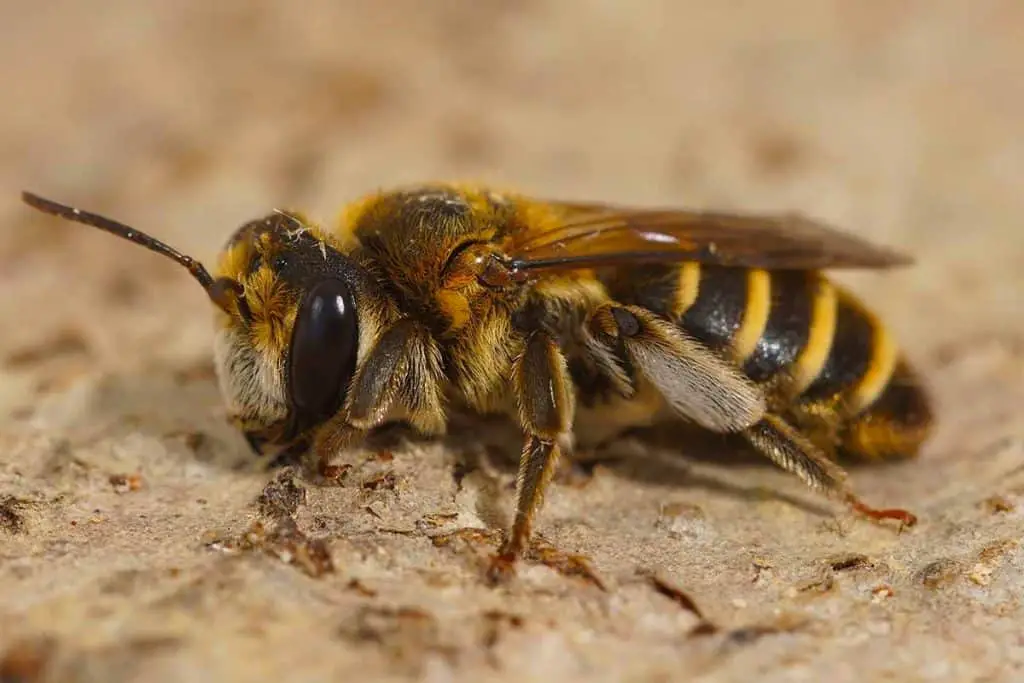
When Are Ground Bees Most & Least Active?
Ground bees are active foragers of pollen from flowers and plants, making them excellent nature’s pollinators.
Their most active time?
Ground bees are most active in March and April. They nest and lay eggs for 6 to 8 weeks before dying, and the late-spring eggs develop underground only to emerge and leave their nests the following spring.
And, their least active period?
Ground bees are least active and hibernate during winter. If you are trying to get rid of them during their active months, aim for dusk when there is less light, and the bees generally stay in the nests.
When Is the Best Time to Kill Ground Bees?
Ground bees are pollinators that benefit the natural ecosystem and generally docile.
But if you must, dusk and night are the best times to kill ground bees as they are less active then.
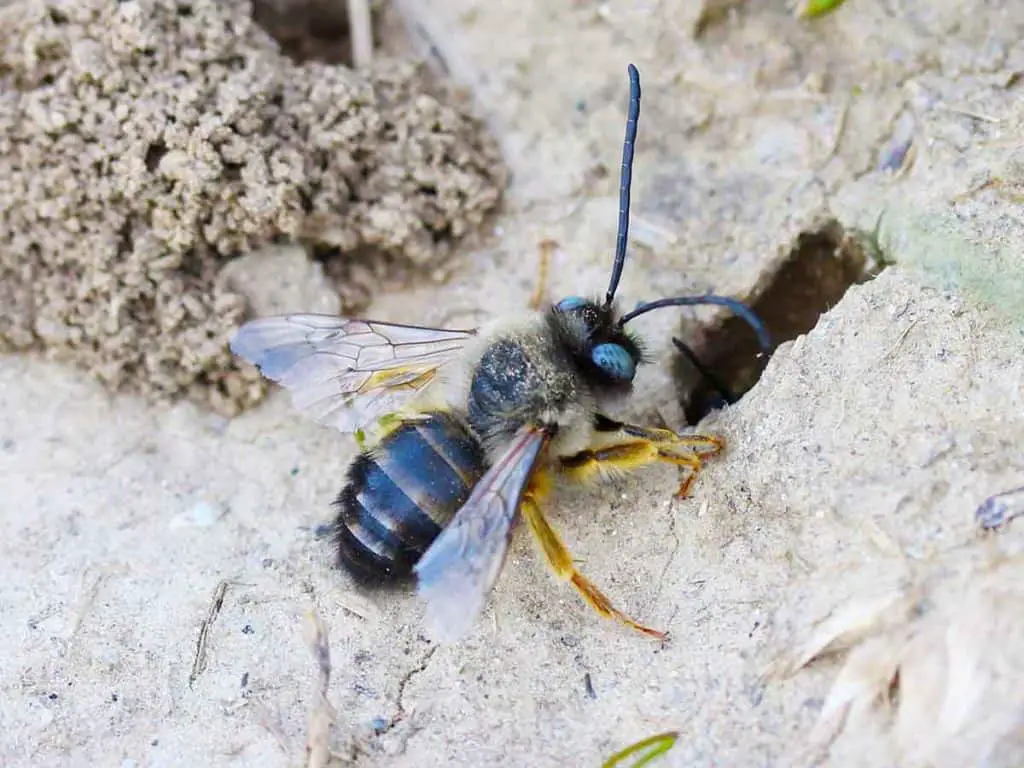
What Kills Ground Bees?
There are many substances and mixtures you can use to repel or get rid of ground bees. They include natural ingredients and chemicals.
Again, most ground bees are harmless and play an essential role in balancing the natural ecosystem. Resort to killing only if your situation necessitates it.
Vinegar:
Does vinegar kill ground bees?
Vinegar is an acetic acid that deters and kills ground bees by drying out their exoskeleton. Mix equal parts of white vinegar and water to kill ground bees, but use apple cider vinegar to treat sting sites.
Cinnamon:
Cinnamon is a spice most kitchens have and a put-off for ground bees.
How to get rid of ground bees with cinnamon?
Sprinkle ground cinnamon on the bees’ burrow holes daily for several days to get rid of ground bees without killing them. Cinnamon does not kill them but is an effective deterrent.
Bleach:
It is another regular household item.
Will bleach kill ground bees?
Bleach is an alkaline liquid that kills ground bees. Mix one part bleach and four parts water, and pour the solution into the burrow. Increase the bleach’s concentration for higher potency.
Remember to wear rubber gloves as bleach is corrosive.
Gasoline:
A product most garages would have, but precautions are a must as it is flammable.
Will gasoline kill ground bees?
Gasoline kills ground bees effectively when done correctly. Do not contaminate the environment by pouring gasoline into the ground. Instead, soak a rag with gasoline and plug it into the burrow holes. The gasoline vapors sink and suffocate the ground bees.
Ammonia:
Ammonia has alkaline properties and is corrosive with a pungent and suffocating odor.
Will ammonia kill ground bees?
You can use ammonia to kill ground bees by pouring a small amount sufficient to flood the burrow’s base where the queen nests. Quickly plug the hole to prevent escape.
Diatomaceous Earth:
Diatomaceous earth is commonly used in pest control as it is very abrasive to an insect’s exoskeleton and cause death by dehydration.
Does diatomaceous earth kill ground bees?
Diatomaceous earth can kill ground bees – sprinkle a generous amount over their burrow and leave it to work. The dust will lose its efficacy when wet after rainfall and would require reapplication. Apply lesser if you wish to let them escape or deter them from coming back.
SEVIN dust:
Sevin is a recognizable brand name in the pest control world. Their bug killer product is available in powder or liquid form.
Does Sevin dust kill ground bees?
Sevin dust acts as a poison that kills ground bees on contact. Sprinkle it into the ground bees’ burrows and not just around the opening. Wear gloves, eyewear, and a mask for your protection from inhaling the dust.
Borax:
An everyday cleaning and laundry aid for home and industrial use.
Will borax kill ground bees?
Borax works effectively in killing ground bees – sprinkle the powder into the burrows and around the openings. Reapplication is necessary after rainfall.
Soapy Water:
You can use any dishwashing liquid mixed with water for pest control purposes.
Will soapy water kill ground bees?
Mix one part dishwashing liquid to four parts water to make soapy water that kills ground bees. Mix them in a spray bottle for spraying the ground bees’ burrows from a safe distance.
Boiling Water:
Can you flood out ground bees?
Flooding the burrows with running water is a simple and affordable method to eliminate ground bees – by drowning or forcing them to leave their nests.
How about using boiling water to kill them?
Boiling water kills solitary ground bees instantly. However, it is not advisable to use boiling water against yellow jackets, which live in colonies and will sting in retaliation. Identify them correctly before employing this method.
Why Do Ground Bees Sting?
Ground bees are generally docile compared to honey bees and hornets.
The female ground bees can and will sting, but they rarely do so unless provoked and need to defend their nests. If you are getting rid of ground bees, the low light in the evening is your best bet to avoid being stung.
What to Do if You Get Stung by Ground Bees?
Ground bees only sting when threatened or feel threatened.
If you get stung by ground bees:
- Remove the stinger immediately.
- Apply ice or a cold compress at the sting site to ease pain and swelling.
- Take a pain reliever as needed.
- If you experience or have a history of an allergic reaction, seek medical attention soonest possible.
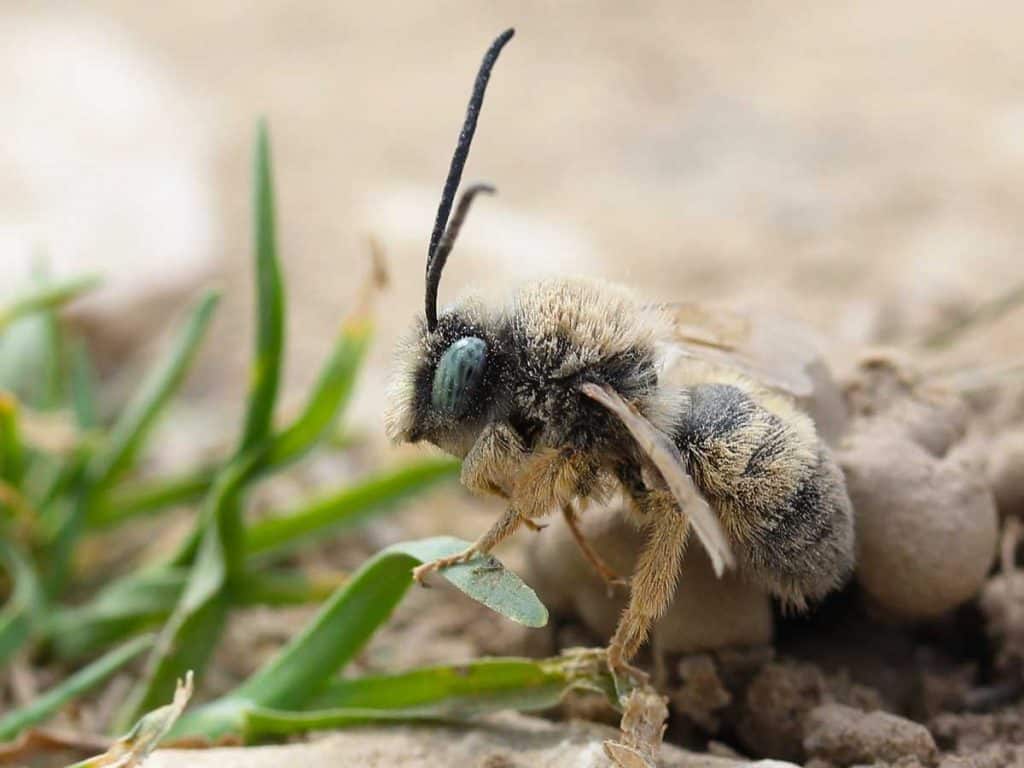
How to Prevent Ground Bees from Coming Back?
Remove the conditions that attract, and you prevent ground bees from coming back:
- After getting rid of the ground bees, shovel up the burrow, fill it in and pack it down.
- Wet the soils in the yard when spring arrives or when you start noticing ground bee activities.
- Grow or thicken the turf to avoid bare patches in your lawn.
- Mulch the soil patches where grass cannot grow.
- Use insecticides only as a last resort.
Types of Ground Bees
Ground-nesting bees include:
- Mason bees
- Sweat bees
- Digger bees
- Leafcutter bees
- Yellow jackets
- Bumblebees
What Animals Eat Ground Bees?
Ground bees are relatively docile compared to other bee species and do not rank highly in their aggression hierarchy, making them food for other animals.
Ground bees have many natural predators, and they include:
- Badgers
- Raccoons
- Skunks
- Armadillos
- Weasels
- Bats
- A variety of birds

Are Yellow Jackets the Same as Ground Bees?
Yellow jackets are a type of ground-nesting wasps, but they are different from ground bees because they live and nest in colonies. They are relatively more aggressive and will sting multiple times in attack or defense.
Unlike yellow jackets, ground bees are solitary insects that burrow for their nests, although you may find multiple burrows in close proximity.
Best Ways to Get Rid of Yellow Jackets
You get rid of yellow jackets the way you would other ground bees, but take extra precaution because they are more aggressive.
The best ways to get rid of yellow jackets:
- Spray with vinegar or liquid dish soap solution.
- Run a vacuum filled with soapy water over the entrance to their nest.
- Flood the nest with water or killer solutions.
- Pour dry ice and plug the burrow.
References:
http://naturemappingfoundation.org/natmap/facts/yellow_jacket_712.html
